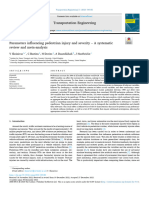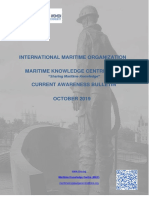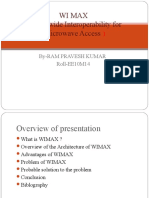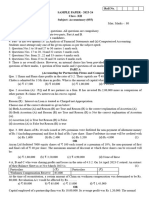Special Journal For RS in 10 Countries - Dec2011
Special Journal For RS in 10 Countries - Dec2011
Uploaded by
Ear ChariyaCopyright:
Available Formats
Special Journal For RS in 10 Countries - Dec2011
Special Journal For RS in 10 Countries - Dec2011
Uploaded by
Ear ChariyaOriginal Title
Copyright
Available Formats
Share this document
Did you find this document useful?
Is this content inappropriate?
Copyright:
Available Formats
Special Journal For RS in 10 Countries - Dec2011
Special Journal For RS in 10 Countries - Dec2011
Uploaded by
Ear ChariyaCopyright:
Available Formats
Trafc Injury Prevention, 13(S1):12, 2012 Copyright C 2012 Taylor & Francis Group, LLC ISSN: 1538-9588 print
/ 1538-957X online DOI: 10.1080/15389588.2011.650023
Editorial
Road Safety in 10 Countries: A Global Opportunity
ADNAN A. HYDER and DAVID BISHAI
International Injury Research Unit, Johns Hopkins Bloomberg School of Public Health, Baltimore, Maryland
More than 1.2 million people die every year in road trafc crashes around the world and an additional 20 to 50 million are injured or disabled (Peden and the World Health Organization [WHO] 2004). This global burden of road trafc injuries (RTIs) is only expected to rise; RTIs are predicted to steadily climb from the ninth leading cause of death in 2004 to the fth leading cause in 2030 (Mathers et al. 2008). Projections also show that RTIs will be one of the 3 leading contributors to the global burden of disease as measured by disability-adjusted life years (DALYs) lost over the next 2 decades (Mathers et al. 2008). Moreover, this burden falls mostly on low- and middle-income countries (LMICs), where the rates of road trafc deaths are twice as high as those in developed countries (WHO 2009). It is estimated that 90 percent of road trafc deaths occur in LMICs even though they account for less than 50 percent of the worlds registered automobiles (WHO 2009). Between 2004 and 2020, these rates are predicted to rise by 27 percent in LMICs, while decreasing in high-income countries by 83 percent, which will further augment the global gap (WHO 2009). The economic losses associated with this burden are signicant; RTIs have been estimated to cost LMICs an estimated US$100 billion every year (World Bank 2010). The Road Safety in 10 Countries Project (RS-10) is a newer multi-country program aimed at reducing the global burden of RTIs and is funded by the Bloomberg Philanthropies with US$125 million over a 5-year timeline (20102014). The RS10 project brings together 6 partners in a consortium: the WHO, Johns Hopkins International Injury Research Unit, the World Bank Global Road Safety Facility, the Global Road Safety Partnership, the Association for Safe International Road Travel, and EMBARQthe World Resources Institute Center for Sustainable Transport. The project focuses on 10 countries that account for almost half (48%) of all trafc deaths globally:
Address correspondence to Adnan A. Hyder, International Injury Research Unit, Johns Hopkins Bloomberg School of Public Health, 615 N. Wolfe Street, Suite E8132, Baltimore, MD 21205. E-mail: ahyder@jhsph.edu
Brazil, Cambodia, China, Egypt, India, Kenya, Mexico, Russia, Turkey, and Vietnam (WHO 2009). RS-10s primary goal is to reduce deaths and serious injuries in these LMICs by focusing on proven preventive and care interventions; identifying high-performing, experienced partners for implementation; and rigorously evaluating outcomes. A relatively standardized approach is being proposed for all RS-10 countries. At the national level, a high-level working group of stakeholders has been created, a joint national work plan has been developed, and 2 or more focused intervention sites (i.e., cities, districts, or regions) have been identied in each country. Each site has been encouraged to focus on at least 2 of 4 potential risk factors (i.e., drunk driving, excessive speed, lack of seat belt and child restraint use, and lack of helmet use), and an evidence-based and nationally relevant set of interventions that address the chosen risk factors will be implemented in each site. Interventions range from infrastructure improvement to enforcement. All relevant sectorshealth, transport, police, and laware being involved as needed and encouraged to participate at the country and site levels. Importantly, an evaluation of the intervention approach has been planned at each site from the outset, and integrates regular monitoring of outputs and a nal outcome assessment at the end of the 5 years. This special issue is devoted to showcasing work from each of the 10 participating countries and highlights selected ndings from the rst 2 years of the projects progress. In Road Trafc Injury in China: a Review of National Data Sources, the authors offer a roadmap of the strengths and drawbacks of the principal data sets describing injuries in China. The paper sheds light on why variant estimates of Chinese injuries have been difcult to align. Projecting the Health and Economic Impact of Road Safety Initiatives: A Case Study of a Multi-country Project also grapples with disparate epidemiological estimates and shows how RS-10 might have a wide range of impacts on health. Despite this range, the dollar value of RS-10 is likely to exceed by tenfold the planned investment of US$125 million. Burden of Road Trafc Injuries in Turkey shows the power of a diligent search to uncover overlooked research on road 1
Downloaded by [203.144.95.152] at 05:28 22 April 2012
EDITORIAL
Downloaded by [203.144.95.152] at 05:28 22 April 2012
safety. The authors discovered a trove of 70 studies on road safety in Turkey that could support the estimate that 2 percent of all deaths in Turkey were due to RTIs. A similar study searching for literature on Egypt found 20 papers and also found that RTIs were responsible for close to 2 percent of deaths in Egypt. Drinking and Driving in Vietnam: Public Knowledge, Attitudes, and Practices collected primary data from a sample of 633 respondents at gas stations to measure a 45 percent self-reported rate of drunk driving. Another primary data-based study, Helmet Use Among Motorcyclists in Cambodia: A Survey of Use, Knowledge, Attitudes, and Perceptions, found a helmet wearing rate of 25 percent at night and 43 percent during the day. Drivers were 10 times more likely to wear helmets than passengers. Seat Belt and Child Seat Use in Lipetskaya Oblast, Russia: Frequencies, Attitudes, and Perceptions also collected primary observational data to determine seat belt use rates of 55 percent of drivers of 25,795 vehicles in Lipetskaya Oblast, Russia. In Road Trafc Injuries in Kenya: The Health Burden and Risk Factors in Two Districts, one sees what can emerge when secondary data from countries were extensively analyzed. Analysis of police data from Kenya was able to generate some of the rst ever estimates of the RTI rate for Kenya at 59.6 per 100,000 in 2009. Secondary data analysis was also used to measure the injury burden in India. Evidence-Based Road Safety Practice in India: Assessment of the Adequacy of Publicly Available Data in Meeting Requirements for Comprehensive Road Safety Data Systems assessed the adequacy of publicly accessible
data sources and found that state-level data on injury in India has important gaps. Quantifying the Underestimated Burden of Road Trafc Mortality in Mexico: A Comparison of Three Approaches and Road Trafc Deaths in Brazil: Rising Trends in Pedestrian and Motorcycle Occupant Deaths illustrate the potential strengths of data analysis when vital registration data are used. In the case of Mexico, investigators found that 19 to 28 percent of the deaths external causes were missing. This special issue of Trafc Injury Prevention offers a great step forward in benchmarking what is known and what is possible to know based on existing injury data and surveillance systems. These results offer guidance for research expectations and opportunities in the current (20112020) decade of action for road safety. REFERENCES
Mathers C, Fat DM, Boerma JT, and World Health Organization. The Global Burden of Disease: 2004 Update. Geneva, Switzerland: World Health Organization; 2008. Peden MM, and the World Health Organization. World Report on Road Trafc Injury Prevention. Geneva, Switzerland: World Health Organization; 2004. World Bank. 2010. Roads & Highways: Road Safety. Available at: http://www.worldbank.org/transport/roads/safety.htm. Accessed June 23, 2010. World Health Organization, Department of Violence and Injury Prevention and Disability. Global Status Report on Road Safety: Time for Action. Geneva, Switzerland: World Health Organization; 2009.
You might also like
- LIL EN-ESLA Test 24v2Document13 pagesLIL EN-ESLA Test 24v2arturopacas1992No ratings yet
- SopDocument2 pagesSopvishalni83% (12)
- Road Safety and Road Traffic Accidents in Saudi Arabia - PMCDocument12 pagesRoad Safety and Road Traffic Accidents in Saudi Arabia - PMCHadi MoizNo ratings yet
- Chapter 2Document9 pagesChapter 2marcaban.farniza81602No ratings yet
- Strategies For Prevention of Road Traffic Injuries (Rtis) in Pakistan: Situational AnalysisDocument5 pagesStrategies For Prevention of Road Traffic Injuries (Rtis) in Pakistan: Situational Analysismuhammad saqibNo ratings yet
- 4745-Article Text-14399-2-10-20190524 PDFDocument22 pages4745-Article Text-14399-2-10-20190524 PDFEric 'robo' BaafiNo ratings yet
- Road Traffic Accident Research in IndiaDocument19 pagesRoad Traffic Accident Research in IndiamAnisH MNo ratings yet
- Taking A 7 E's' Approach To Road Safety in The UK and BeyondDocument8 pagesTaking A 7 E's' Approach To Road Safety in The UK and BeyondTico RuiterNo ratings yet
- Scoping Review Intervention in Road Traffic AccidentDocument8 pagesScoping Review Intervention in Road Traffic AccidentNur AtiqahNo ratings yet
- Study of Road Traffic Accident Cases Reported in A Tertiary Care Hospital inDocument8 pagesStudy of Road Traffic Accident Cases Reported in A Tertiary Care Hospital inNunungNo ratings yet
- Universal Motorcycle Helmet Laws To Reduce Injuries: A Community Guide Systematic ReviewDocument13 pagesUniversal Motorcycle Helmet Laws To Reduce Injuries: A Community Guide Systematic ReviewLas UkcuNo ratings yet
- ShrinivasDocument27 pagesShrinivasFabio Antonio Villadiego FontanillaNo ratings yet
- Literature Review On Road Accidents in KenyaDocument4 pagesLiterature Review On Road Accidents in Kenyaafmzitaaoxahvp100% (1)
- Accident Analysis and Prevention: SciencedirectDocument15 pagesAccident Analysis and Prevention: SciencedirecteirinaNo ratings yet
- Investigation of Road Accidents in Ghana. A Case Study To Ascertain The Standard Criteria For Vehicle Evaluation and InspectionDocument33 pagesInvestigation of Road Accidents in Ghana. A Case Study To Ascertain The Standard Criteria For Vehicle Evaluation and InspectionAfful Frank OseiNo ratings yet
- PhiliDocument27 pagesPhiliFreddie Fernandez Ribo Jr.No ratings yet
- Socio-Economic Costing of Road Traffic Accidents: Evidence From Nagpur City, Maharashtra, IndiaDocument9 pagesSocio-Economic Costing of Road Traffic Accidents: Evidence From Nagpur City, Maharashtra, IndiabahugunaNo ratings yet
- 3874-Article Text-54241-4-10-20220321Document14 pages3874-Article Text-54241-4-10-20220321BJ AbelaNo ratings yet
- EgyptDocument7 pagesEgyptTrang QuỳnhNo ratings yet
- Hardboundlakim Estrada Chapters 1234 EditedDocument43 pagesHardboundlakim Estrada Chapters 1234 EditedAngelo Lakim100% (1)
- Road Safety Measures: October 2014Document9 pagesRoad Safety Measures: October 2014Riffat BokhariNo ratings yet
- Road Accident Literature ReviewDocument5 pagesRoad Accident Literature Reviewafmzqlbvdfeenz100% (1)
- High Traffic Injury Rates: From: Team 5 (Malak Soliman, Mohammed Musmar, Mohammed Al Rasheed, LeenDocument10 pagesHigh Traffic Injury Rates: From: Team 5 (Malak Soliman, Mohammed Musmar, Mohammed Al Rasheed, Leenapi-727214816No ratings yet
- Prediction of Factors in Vehicular Accident Using Machine LearningDocument7 pagesPrediction of Factors in Vehicular Accident Using Machine LearningPatrick D CernaNo ratings yet
- Research BasicDocument12 pagesResearch BasicmasreshaNo ratings yet
- Road Traffic InjuriesDocument5 pagesRoad Traffic InjuriesCiclistas Urbanos de QuitoNo ratings yet
- Thesis 022643Document45 pagesThesis 022643Max PaineNo ratings yet
- Mick Term PaperDocument21 pagesMick Term PaperNoyuoroNo ratings yet
- 1 s2.0 S1877042813045904 MainDocument10 pages1 s2.0 S1877042813045904 MainNoel S. De Juan Jr.No ratings yet
- For Severe and Fatal Road Traffic AccidentsDocument9 pagesFor Severe and Fatal Road Traffic AccidentstilahunNo ratings yet
- Ajol File Journals - 336 - Articles - 58286 - Submission - Proof - 58286 4009 103324 1 10 20100823Document20 pagesAjol File Journals - 336 - Articles - 58286 - Submission - Proof - 58286 4009 103324 1 10 20100823Noel S. De Juan Jr.No ratings yet
- Trends in Traffic Collisions and Injuries in Kyrgyzstan, 2003-2007Document7 pagesTrends in Traffic Collisions and Injuries in Kyrgyzstan, 2003-2007Wendy SetiawanNo ratings yet
- Factors Associated With Motorcycle-Related Road TRDocument14 pagesFactors Associated With Motorcycle-Related Road TRNilanka HarshaniNo ratings yet
- Ffic Injuries: A Comparison of Road User Types: Health Care and Productivity Costs of Non-Fatal TraDocument16 pagesFfic Injuries: A Comparison of Road User Types: Health Care and Productivity Costs of Non-Fatal TraChrestian EspenocillaNo ratings yet
- Thesis On Road Traffic AccidentsDocument6 pagesThesis On Road Traffic Accidentsmelissajimenezmilwaukee100% (2)
- Media Centre: Road Traffic InjuriesDocument4 pagesMedia Centre: Road Traffic InjuriesPieqka RahmanNo ratings yet
- Predictive Model For Accident Management SystemDocument7 pagesPredictive Model For Accident Management SystemInternational Journal of Application or Innovation in Engineering & ManagementNo ratings yet
- Balakrishnan 2019Document8 pagesBalakrishnan 2019Sumayya NazninNo ratings yet
- 1495444517.3651road Traffic AccidentDocument5 pages1495444517.3651road Traffic AccidentNejib GhazouaniNo ratings yet
- Roadway Safety Assessment and Test Application of iRAP Along National Highway 3 in Haiti PDFDocument24 pagesRoadway Safety Assessment and Test Application of iRAP Along National Highway 3 in Haiti PDFShuaib IsmailNo ratings yet
- The Future of Road Safety. 2023Document24 pagesThe Future of Road Safety. 2023EUDEMBERGNo ratings yet
- Cirrelt 2008 48Document35 pagesCirrelt 2008 48Ionut PascalNo ratings yet
- Cahilig RRLDocument5 pagesCahilig RRLJc Daylle GapoyNo ratings yet
- 14 Ijsrcse 04156Document12 pages14 Ijsrcse 04156Durga Devi PNo ratings yet
- Literature Review On Road Traffic AccidentsDocument6 pagesLiterature Review On Road Traffic Accidentsc5kby94s100% (1)
- Road Safety DissertationDocument4 pagesRoad Safety DissertationOnlinePaperWritingServicesSingapore100% (1)
- Research Report - Road Safety in Bangladesh-Ground Realities and Action Imperatives PDFDocument106 pagesResearch Report - Road Safety in Bangladesh-Ground Realities and Action Imperatives PDFYeasir HasanNo ratings yet
- Ijerph 17 02110 v2Document12 pagesIjerph 17 02110 v2SHULZ HASSANNo ratings yet
- Traffic Accidents Analysis and Cost Mode PDFDocument14 pagesTraffic Accidents Analysis and Cost Mode PDFhikmatullah4No ratings yet
- Accident Rate Literature ReviewDocument5 pagesAccident Rate Literature Review222901001No ratings yet
- Regression Analysis of Road Traffic Accidents and Population Growth in GhanaDocument7 pagesRegression Analysis of Road Traffic Accidents and Population Growth in GhanaApam BenjaminNo ratings yet
- Road Safety Problems in Bangladesh Achievable TargDocument7 pagesRoad Safety Problems in Bangladesh Achievable TargSawaluddin SawalNo ratings yet
- IIT M - Investigation of Factors Contributing To Pedestrian Hit and Run Crashes in IndiaDocument23 pagesIIT M - Investigation of Factors Contributing To Pedestrian Hit and Run Crashes in IndiaSankhadeepNo ratings yet
- Pediatrics 2010 Weiss 1149 55bTBIDocument9 pagesPediatrics 2010 Weiss 1149 55bTBIseymourwardNo ratings yet
- Road Safety AwarenessDocument9 pagesRoad Safety AwarenessasadNo ratings yet
- RS Highways 7Document9 pagesRS Highways 7Keshav JangraNo ratings yet
- cos_linspaceDocument9 pagescos_linspacemohamedfadda2244No ratings yet
- Built Environment and Traffic Safety - Review of Empirical EvidenceDocument22 pagesBuilt Environment and Traffic Safety - Review of Empirical EvidencenextSTL.comNo ratings yet
- 9 Ea 8Document5 pages9 Ea 8Marie Francoise BautistaNo ratings yet
- Impact of Transportation On Social-Economic Development: A Case Study of Jaipur City Vikas MeenaDocument12 pagesImpact of Transportation On Social-Economic Development: A Case Study of Jaipur City Vikas Meenaharesh1986No ratings yet
- RRL CivilDocument11 pagesRRL CivilDick Jefferson Ocampo PatingNo ratings yet
- A Practical Guide to Human Factors Analysis and Classification System (HFACS) 7.0From EverandA Practical Guide to Human Factors Analysis and Classification System (HFACS) 7.0Rating: 5 out of 5 stars5/5 (1)
- Qbank FormatDocument5 pagesQbank FormatpashaNo ratings yet
- LogDocument129 pagesLogahandankoudoupierremarcousrovaNo ratings yet
- 150 Words EssayDocument50 pages150 Words EssayafhbexrciNo ratings yet
- Knn1 HouseVotesDocument2 pagesKnn1 HouseVotesJoe1No ratings yet
- Laptop Bags CatalogueDocument52 pagesLaptop Bags CatalogueAkshaykumarNo ratings yet
- Master 4 AMSA Exam Checklist PDFDocument2 pagesMaster 4 AMSA Exam Checklist PDFraehedNo ratings yet
- Chap 09Document26 pagesChap 09Ghazala AdnanNo ratings yet
- The Role of Marketing Strategy in Determining Consumer Purchasing BehaviourDocument74 pagesThe Role of Marketing Strategy in Determining Consumer Purchasing BehaviourSourav MandalNo ratings yet
- Invitrogen Price List 2016 (Duty Paid)Document253 pagesInvitrogen Price List 2016 (Duty Paid)Khristin AllisonNo ratings yet
- CAB 275 October 2019Document58 pagesCAB 275 October 2019JCANo ratings yet
- REVIEW: U.S. Military Base Ghana AgreementDocument16 pagesREVIEW: U.S. Military Base Ghana AgreementYedidiahNo ratings yet
- Cartridge Type Boring BarDocument4 pagesCartridge Type Boring BarvishalNo ratings yet
- MGA Policy On Outsourcing by Authorised PersonsDocument15 pagesMGA Policy On Outsourcing by Authorised PersonsMaria CECILIA S CARMONANo ratings yet
- ECE 461/561-001: Communication Systems Design: Min MaxDocument5 pagesECE 461/561-001: Communication Systems Design: Min MaxZhenyu HuoNo ratings yet
- Sandhya 2005Document4 pagesSandhya 2005abhinayn16phdNo ratings yet
- Wi Max (Worldwide Interoperability For Microwave Access: By-Ram Pravesh Kumar Roll-EE10M14Document13 pagesWi Max (Worldwide Interoperability For Microwave Access: By-Ram Pravesh Kumar Roll-EE10M14rampravesh kumarNo ratings yet
- Concept of Owner Vs Concept of HolderDocument2 pagesConcept of Owner Vs Concept of HolderAljay DAHANNo ratings yet
- MGT6204 Topic 5 Organising Principles and Organisational DesignDocument43 pagesMGT6204 Topic 5 Organising Principles and Organisational DesignTanapal A/L BalaramanNo ratings yet
- Chery-QQ S11 Transmisión Parte 4Document17 pagesChery-QQ S11 Transmisión Parte 4limadacarlos100% (1)
- 2024 Sample PPPDocument5 pages2024 Sample PPPcherelynbandojo16No ratings yet
- Six The Musical - Ex WivesDocument18 pagesSix The Musical - Ex Wiveswolter.alexa100% (1)
- PWD Friendly EstablishmentDocument7 pagesPWD Friendly EstablishmentJenzel Nerie SalcedaNo ratings yet
- Mock SQP Accountancy Class 12 Cbse BoardDocument17 pagesMock SQP Accountancy Class 12 Cbse BoardChetna SharmaNo ratings yet
- Maintenance of Crawl CraneDocument30 pagesMaintenance of Crawl Craneminthu khitNo ratings yet
- History of InternetDocument23 pagesHistory of InternetCornell DagotNo ratings yet
- Nike ReportDocument12 pagesNike ReportJoseline MillaNo ratings yet
- Affidavit of Fact Title Dispute To America Sovereign OriginalDocument5 pagesAffidavit of Fact Title Dispute To America Sovereign OriginalWesley-Keith: Mullings100% (7)
- Borlasa Vs PolisticoDocument2 pagesBorlasa Vs PolisticoKim Lorenzo CalatravaNo ratings yet

























































































